STAT6001 Report: Public Health Informatics Analysis and Evaluation
VerifiedAdded on 2022/11/26
|12
|3722
|150
Report
AI Summary
This report, prepared for STAT6001, delves into the realm of public health informatics. It begins with a detailed review of three public health-related Twitter accounts (@Croakeyblog, @ehealthpaho, and @equitylist), summarizing their content and impact over a five-week period. The report then transitions to an analysis of telemedicine in Australia, exploring the concept, barriers to its uptake, and the classification of ICT and management issues. It further evaluates current methods and provides practical, evidence-based recommendations for improving telemedicine implementation. The report highlights the importance of funding, infrastructure, and skill development in the context of telemedicine adoption, particularly in rural areas. The report also touches on the role of information and communication technology in healthcare, examining the benefits and challenges of integrating these technologies.
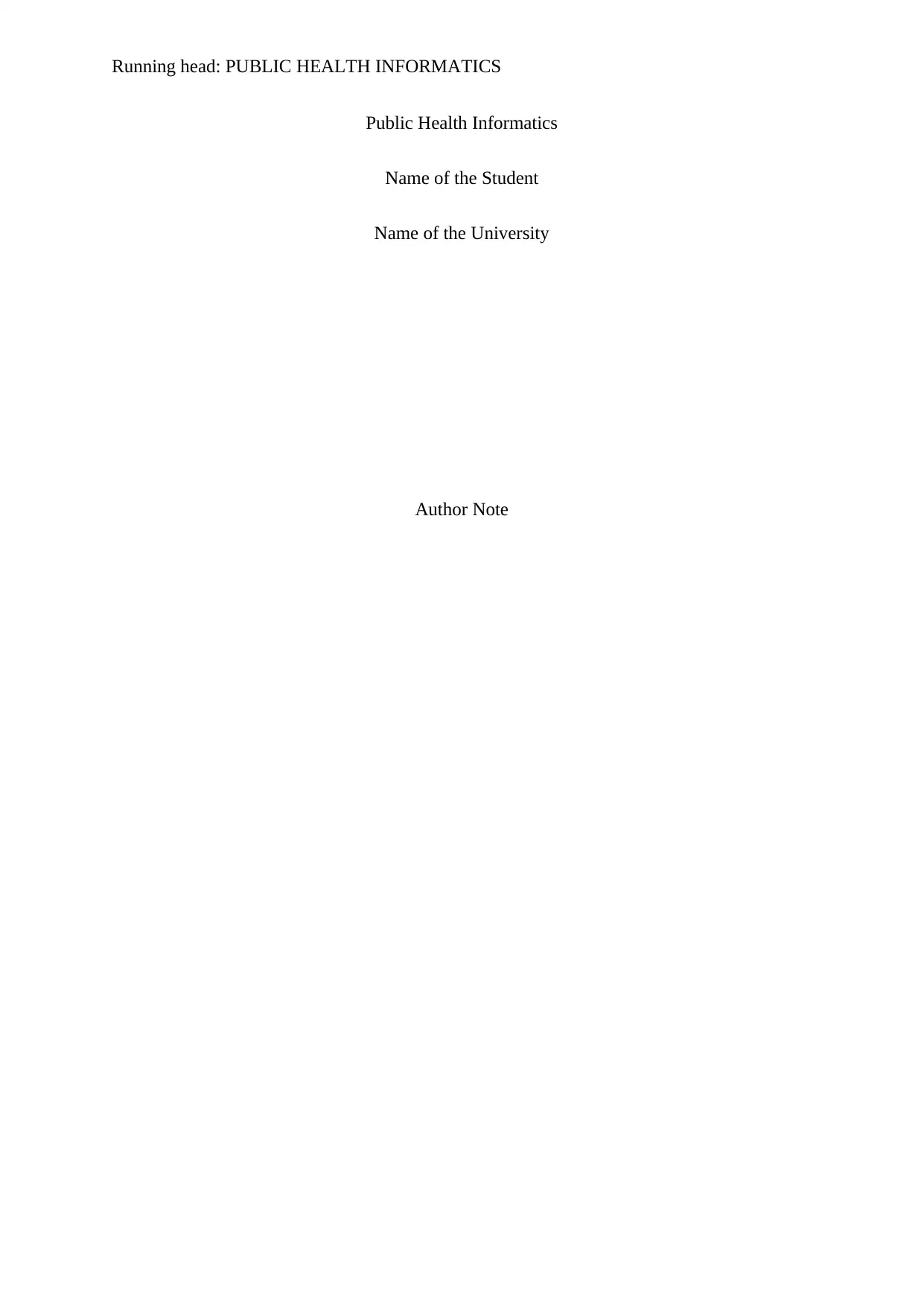
Running head: PUBLIC HEALTH INFORMATICS
Public Health Informatics
Name of the Student
Name of the University
Author Note
Public Health Informatics
Name of the Student
Name of the University
Author Note
Paraphrase This Document
Need a fresh take? Get an instant paraphrase of this document with our AI Paraphraser
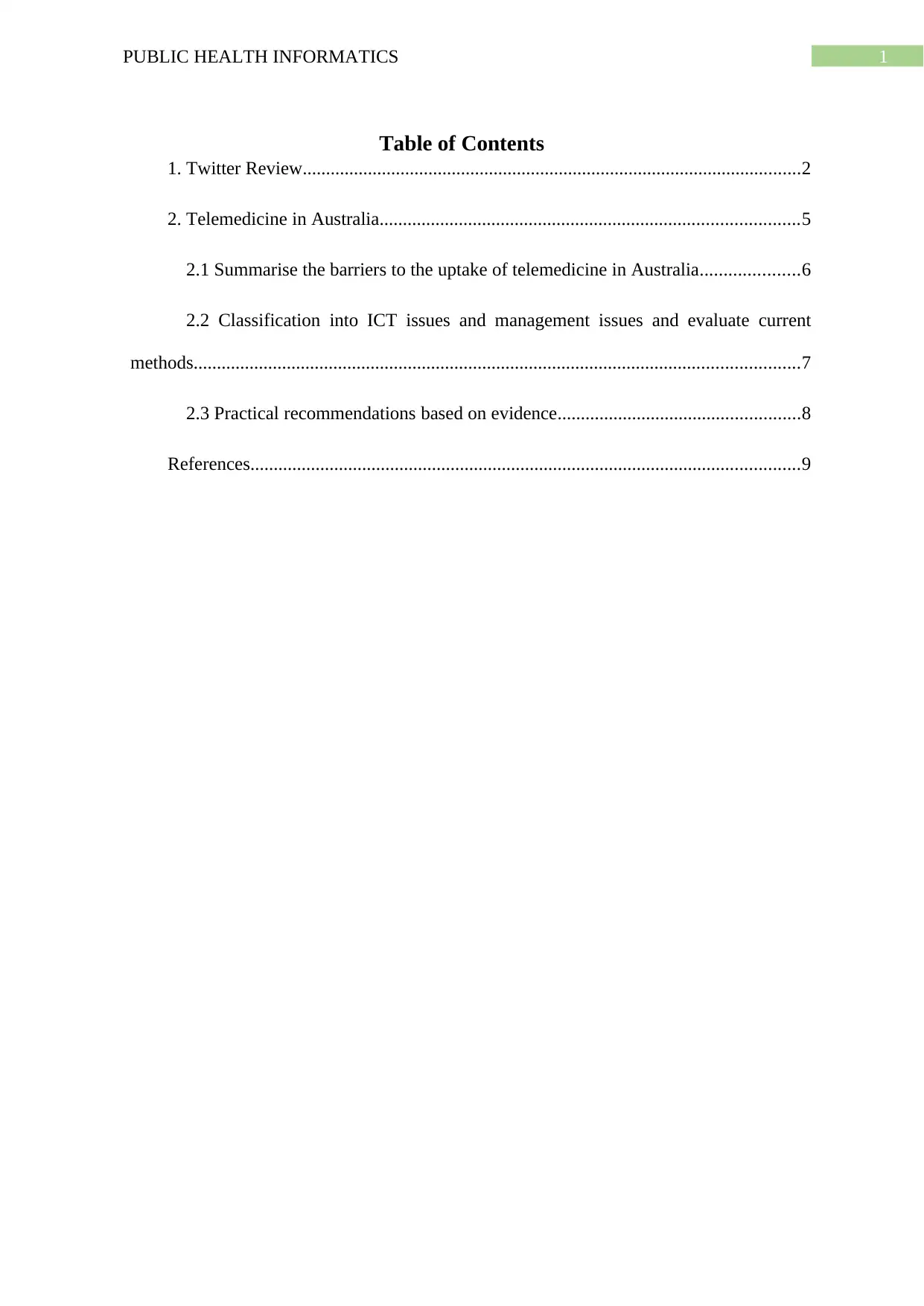
1PUBLIC HEALTH INFORMATICS
Table of Contents
1. Twitter Review...........................................................................................................2
2. Telemedicine in Australia..........................................................................................5
2.1 Summarise the barriers to the uptake of telemedicine in Australia.....................6
2.2 Classification into ICT issues and management issues and evaluate current
methods..................................................................................................................................7
2.3 Practical recommendations based on evidence....................................................8
References......................................................................................................................9
Table of Contents
1. Twitter Review...........................................................................................................2
2. Telemedicine in Australia..........................................................................................5
2.1 Summarise the barriers to the uptake of telemedicine in Australia.....................6
2.2 Classification into ICT issues and management issues and evaluate current
methods..................................................................................................................................7
2.3 Practical recommendations based on evidence....................................................8
References......................................................................................................................9
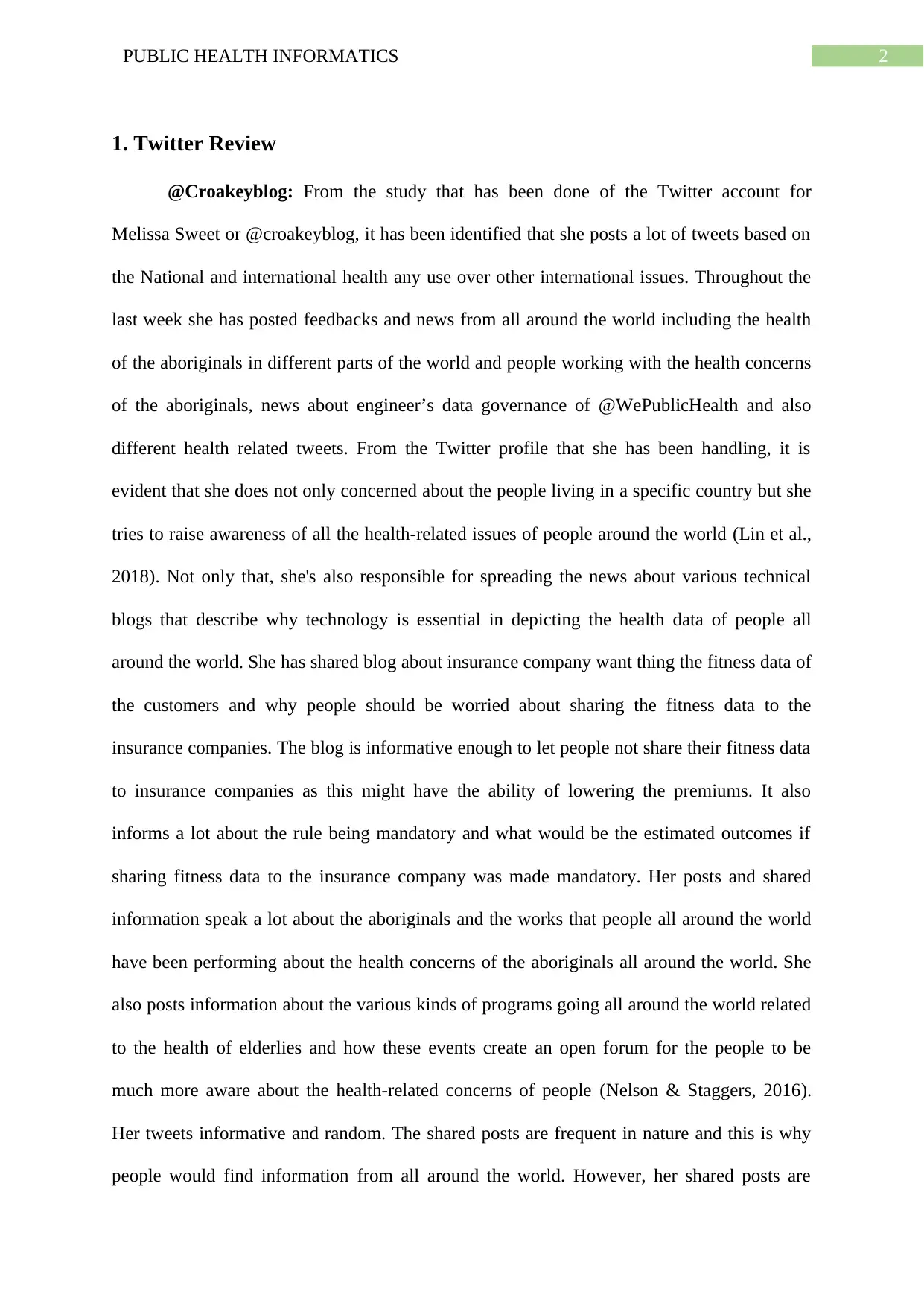
2PUBLIC HEALTH INFORMATICS
1. Twitter Review
@Croakeyblog: From the study that has been done of the Twitter account for
Melissa Sweet or @croakeyblog, it has been identified that she posts a lot of tweets based on
the National and international health any use over other international issues. Throughout the
last week she has posted feedbacks and news from all around the world including the health
of the aboriginals in different parts of the world and people working with the health concerns
of the aboriginals, news about engineer’s data governance of @WePublicHealth and also
different health related tweets. From the Twitter profile that she has been handling, it is
evident that she does not only concerned about the people living in a specific country but she
tries to raise awareness of all the health-related issues of people around the world (Lin et al.,
2018). Not only that, she's also responsible for spreading the news about various technical
blogs that describe why technology is essential in depicting the health data of people all
around the world. She has shared blog about insurance company want thing the fitness data of
the customers and why people should be worried about sharing the fitness data to the
insurance companies. The blog is informative enough to let people not share their fitness data
to insurance companies as this might have the ability of lowering the premiums. It also
informs a lot about the rule being mandatory and what would be the estimated outcomes if
sharing fitness data to the insurance company was made mandatory. Her posts and shared
information speak a lot about the aboriginals and the works that people all around the world
have been performing about the health concerns of the aboriginals all around the world. She
also posts information about the various kinds of programs going all around the world related
to the health of elderlies and how these events create an open forum for the people to be
much more aware about the health-related concerns of people (Nelson & Staggers, 2016).
Her tweets informative and random. The shared posts are frequent in nature and this is why
people would find information from all around the world. However, her shared posts are
1. Twitter Review
@Croakeyblog: From the study that has been done of the Twitter account for
Melissa Sweet or @croakeyblog, it has been identified that she posts a lot of tweets based on
the National and international health any use over other international issues. Throughout the
last week she has posted feedbacks and news from all around the world including the health
of the aboriginals in different parts of the world and people working with the health concerns
of the aboriginals, news about engineer’s data governance of @WePublicHealth and also
different health related tweets. From the Twitter profile that she has been handling, it is
evident that she does not only concerned about the people living in a specific country but she
tries to raise awareness of all the health-related issues of people around the world (Lin et al.,
2018). Not only that, she's also responsible for spreading the news about various technical
blogs that describe why technology is essential in depicting the health data of people all
around the world. She has shared blog about insurance company want thing the fitness data of
the customers and why people should be worried about sharing the fitness data to the
insurance companies. The blog is informative enough to let people not share their fitness data
to insurance companies as this might have the ability of lowering the premiums. It also
informs a lot about the rule being mandatory and what would be the estimated outcomes if
sharing fitness data to the insurance company was made mandatory. Her posts and shared
information speak a lot about the aboriginals and the works that people all around the world
have been performing about the health concerns of the aboriginals all around the world. She
also posts information about the various kinds of programs going all around the world related
to the health of elderlies and how these events create an open forum for the people to be
much more aware about the health-related concerns of people (Nelson & Staggers, 2016).
Her tweets informative and random. The shared posts are frequent in nature and this is why
people would find information from all around the world. However, her shared posts are
⊘ This is a preview!⊘
Do you want full access?
Subscribe today to unlock all pages.

Trusted by 1+ million students worldwide
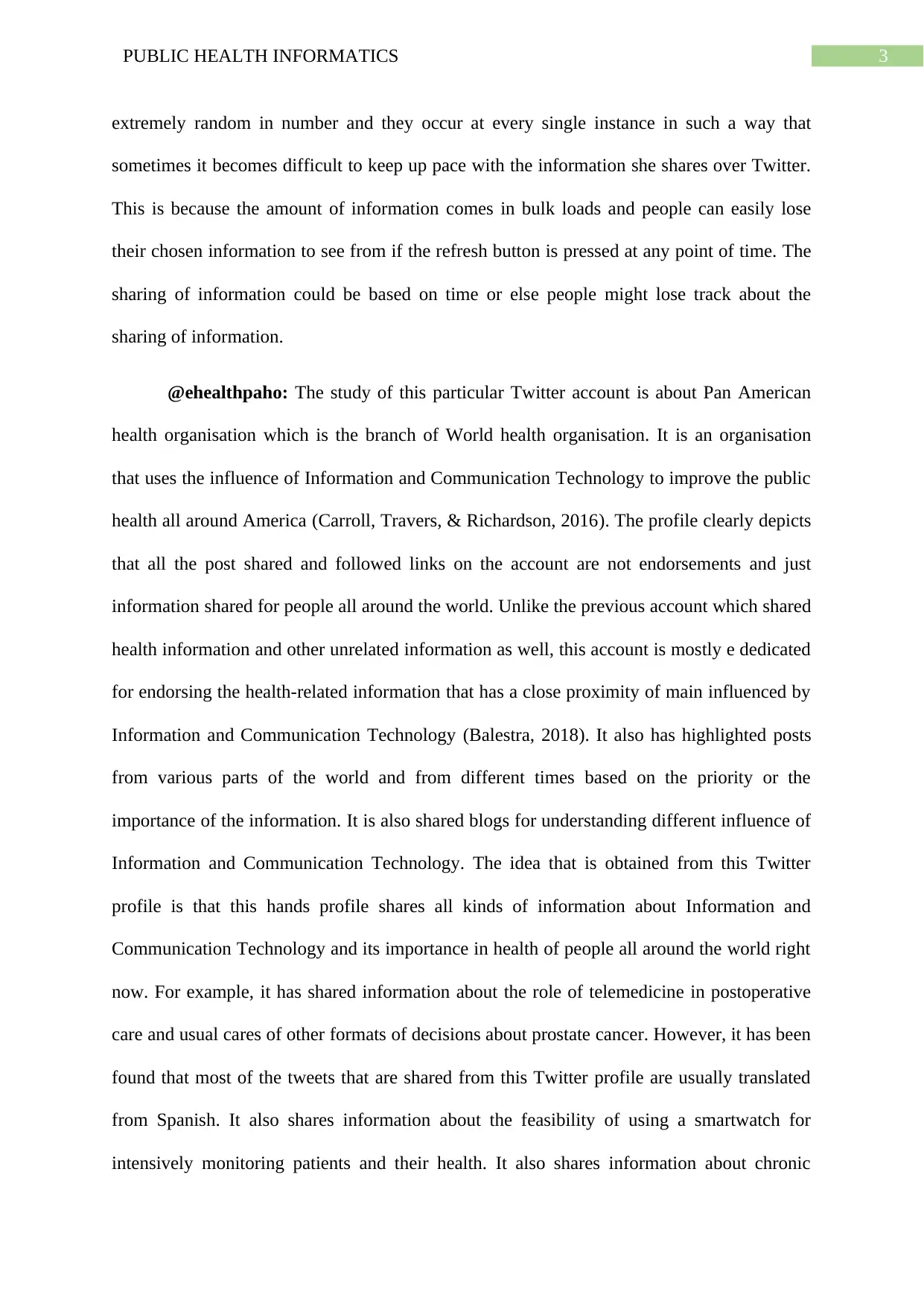
3PUBLIC HEALTH INFORMATICS
extremely random in number and they occur at every single instance in such a way that
sometimes it becomes difficult to keep up pace with the information she shares over Twitter.
This is because the amount of information comes in bulk loads and people can easily lose
their chosen information to see from if the refresh button is pressed at any point of time. The
sharing of information could be based on time or else people might lose track about the
sharing of information.
@ehealthpaho: The study of this particular Twitter account is about Pan American
health organisation which is the branch of World health organisation. It is an organisation
that uses the influence of Information and Communication Technology to improve the public
health all around America (Carroll, Travers, & Richardson, 2016). The profile clearly depicts
that all the post shared and followed links on the account are not endorsements and just
information shared for people all around the world. Unlike the previous account which shared
health information and other unrelated information as well, this account is mostly e dedicated
for endorsing the health-related information that has a close proximity of main influenced by
Information and Communication Technology (Balestra, 2018). It also has highlighted posts
from various parts of the world and from different times based on the priority or the
importance of the information. It is also shared blogs for understanding different influence of
Information and Communication Technology. The idea that is obtained from this Twitter
profile is that this hands profile shares all kinds of information about Information and
Communication Technology and its importance in health of people all around the world right
now. For example, it has shared information about the role of telemedicine in postoperative
care and usual cares of other formats of decisions about prostate cancer. However, it has been
found that most of the tweets that are shared from this Twitter profile are usually translated
from Spanish. It also shares information about the feasibility of using a smartwatch for
intensively monitoring patients and their health. It also shares information about chronic
extremely random in number and they occur at every single instance in such a way that
sometimes it becomes difficult to keep up pace with the information she shares over Twitter.
This is because the amount of information comes in bulk loads and people can easily lose
their chosen information to see from if the refresh button is pressed at any point of time. The
sharing of information could be based on time or else people might lose track about the
sharing of information.
@ehealthpaho: The study of this particular Twitter account is about Pan American
health organisation which is the branch of World health organisation. It is an organisation
that uses the influence of Information and Communication Technology to improve the public
health all around America (Carroll, Travers, & Richardson, 2016). The profile clearly depicts
that all the post shared and followed links on the account are not endorsements and just
information shared for people all around the world. Unlike the previous account which shared
health information and other unrelated information as well, this account is mostly e dedicated
for endorsing the health-related information that has a close proximity of main influenced by
Information and Communication Technology (Balestra, 2018). It also has highlighted posts
from various parts of the world and from different times based on the priority or the
importance of the information. It is also shared blogs for understanding different influence of
Information and Communication Technology. The idea that is obtained from this Twitter
profile is that this hands profile shares all kinds of information about Information and
Communication Technology and its importance in health of people all around the world right
now. For example, it has shared information about the role of telemedicine in postoperative
care and usual cares of other formats of decisions about prostate cancer. However, it has been
found that most of the tweets that are shared from this Twitter profile are usually translated
from Spanish. It also shares information about the feasibility of using a smartwatch for
intensively monitoring patients and their health. It also shares information about chronic
Paraphrase This Document
Need a fresh take? Get an instant paraphrase of this document with our AI Paraphraser
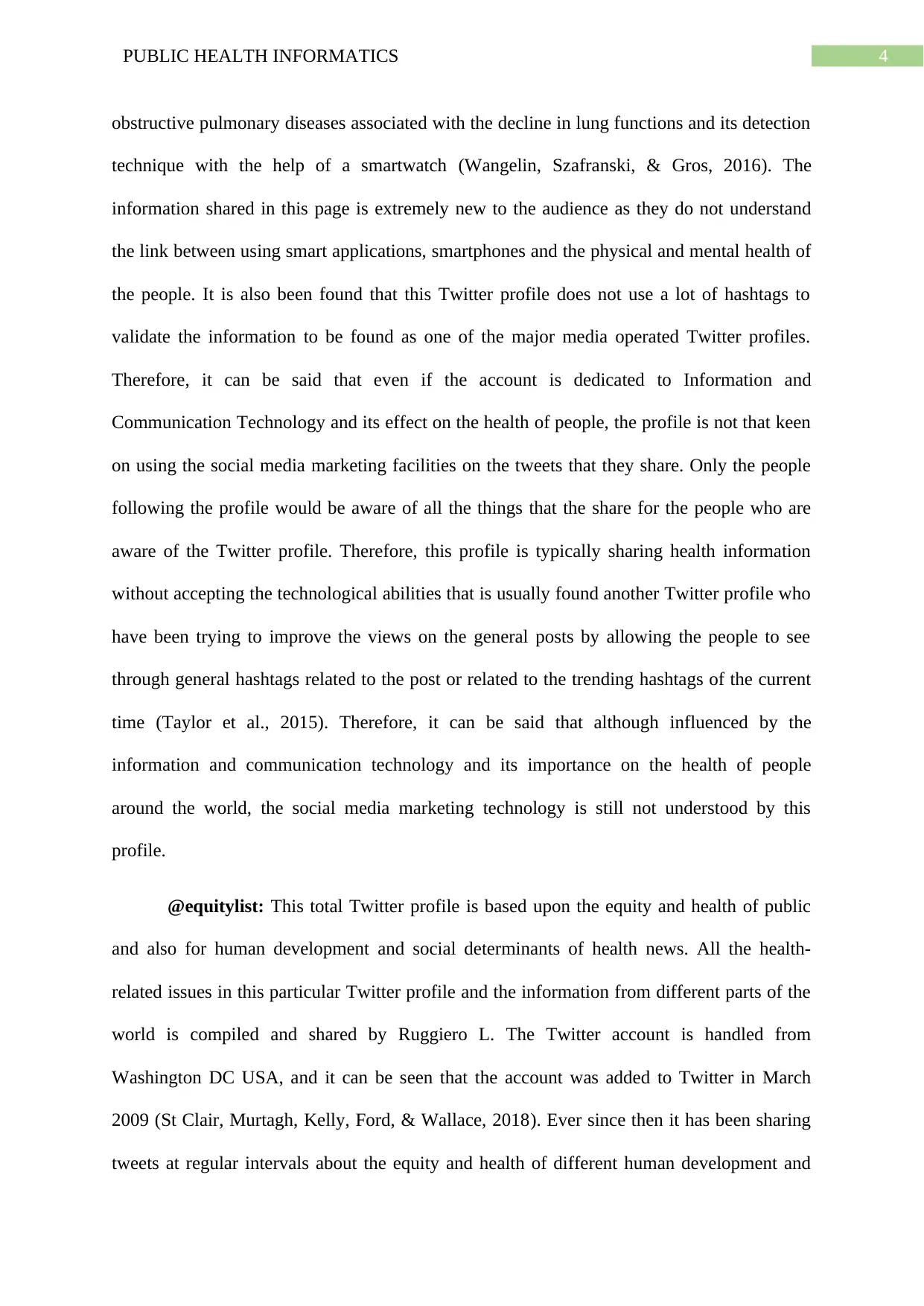
4PUBLIC HEALTH INFORMATICS
obstructive pulmonary diseases associated with the decline in lung functions and its detection
technique with the help of a smartwatch (Wangelin, Szafranski, & Gros, 2016). The
information shared in this page is extremely new to the audience as they do not understand
the link between using smart applications, smartphones and the physical and mental health of
the people. It is also been found that this Twitter profile does not use a lot of hashtags to
validate the information to be found as one of the major media operated Twitter profiles.
Therefore, it can be said that even if the account is dedicated to Information and
Communication Technology and its effect on the health of people, the profile is not that keen
on using the social media marketing facilities on the tweets that they share. Only the people
following the profile would be aware of all the things that the share for the people who are
aware of the Twitter profile. Therefore, this profile is typically sharing health information
without accepting the technological abilities that is usually found another Twitter profile who
have been trying to improve the views on the general posts by allowing the people to see
through general hashtags related to the post or related to the trending hashtags of the current
time (Taylor et al., 2015). Therefore, it can be said that although influenced by the
information and communication technology and its importance on the health of people
around the world, the social media marketing technology is still not understood by this
profile.
@equitylist: This total Twitter profile is based upon the equity and health of public
and also for human development and social determinants of health news. All the health-
related issues in this particular Twitter profile and the information from different parts of the
world is compiled and shared by Ruggiero L. The Twitter account is handled from
Washington DC USA, and it can be seen that the account was added to Twitter in March
2009 (St Clair, Murtagh, Kelly, Ford, & Wallace, 2018). Ever since then it has been sharing
tweets at regular intervals about the equity and health of different human development and
obstructive pulmonary diseases associated with the decline in lung functions and its detection
technique with the help of a smartwatch (Wangelin, Szafranski, & Gros, 2016). The
information shared in this page is extremely new to the audience as they do not understand
the link between using smart applications, smartphones and the physical and mental health of
the people. It is also been found that this Twitter profile does not use a lot of hashtags to
validate the information to be found as one of the major media operated Twitter profiles.
Therefore, it can be said that even if the account is dedicated to Information and
Communication Technology and its effect on the health of people, the profile is not that keen
on using the social media marketing facilities on the tweets that they share. Only the people
following the profile would be aware of all the things that the share for the people who are
aware of the Twitter profile. Therefore, this profile is typically sharing health information
without accepting the technological abilities that is usually found another Twitter profile who
have been trying to improve the views on the general posts by allowing the people to see
through general hashtags related to the post or related to the trending hashtags of the current
time (Taylor et al., 2015). Therefore, it can be said that although influenced by the
information and communication technology and its importance on the health of people
around the world, the social media marketing technology is still not understood by this
profile.
@equitylist: This total Twitter profile is based upon the equity and health of public
and also for human development and social determinants of health news. All the health-
related issues in this particular Twitter profile and the information from different parts of the
world is compiled and shared by Ruggiero L. The Twitter account is handled from
Washington DC USA, and it can be seen that the account was added to Twitter in March
2009 (St Clair, Murtagh, Kelly, Ford, & Wallace, 2018). Ever since then it has been sharing
tweets at regular intervals about the equity and health of different human development and
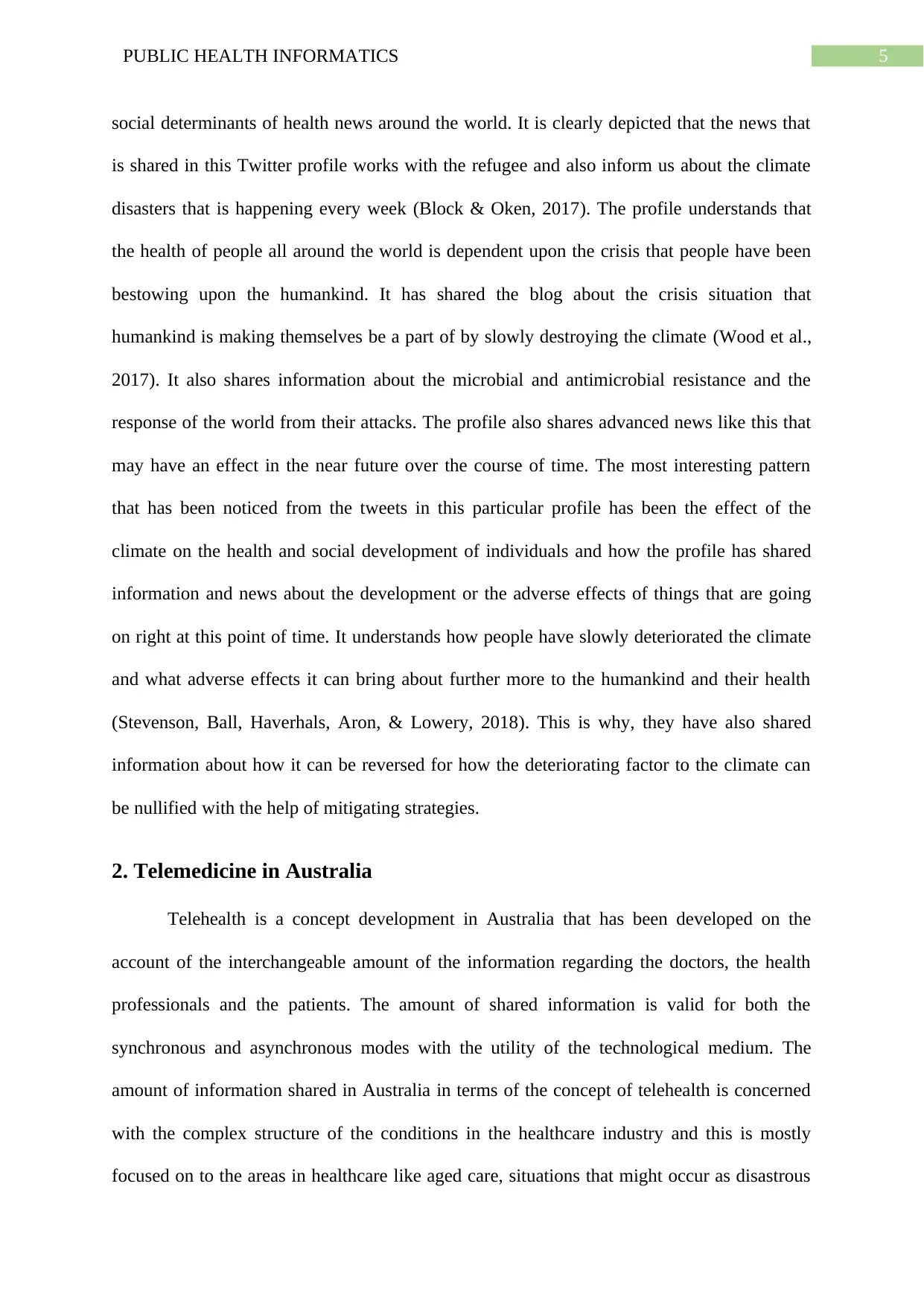
5PUBLIC HEALTH INFORMATICS
social determinants of health news around the world. It is clearly depicted that the news that
is shared in this Twitter profile works with the refugee and also inform us about the climate
disasters that is happening every week (Block & Oken, 2017). The profile understands that
the health of people all around the world is dependent upon the crisis that people have been
bestowing upon the humankind. It has shared the blog about the crisis situation that
humankind is making themselves be a part of by slowly destroying the climate (Wood et al.,
2017). It also shares information about the microbial and antimicrobial resistance and the
response of the world from their attacks. The profile also shares advanced news like this that
may have an effect in the near future over the course of time. The most interesting pattern
that has been noticed from the tweets in this particular profile has been the effect of the
climate on the health and social development of individuals and how the profile has shared
information and news about the development or the adverse effects of things that are going
on right at this point of time. It understands how people have slowly deteriorated the climate
and what adverse effects it can bring about further more to the humankind and their health
(Stevenson, Ball, Haverhals, Aron, & Lowery, 2018). This is why, they have also shared
information about how it can be reversed for how the deteriorating factor to the climate can
be nullified with the help of mitigating strategies.
2. Telemedicine in Australia
Telehealth is a concept development in Australia that has been developed on the
account of the interchangeable amount of the information regarding the doctors, the health
professionals and the patients. The amount of shared information is valid for both the
synchronous and asynchronous modes with the utility of the technological medium. The
amount of information shared in Australia in terms of the concept of telehealth is concerned
with the complex structure of the conditions in the healthcare industry and this is mostly
focused on to the areas in healthcare like aged care, situations that might occur as disastrous
social determinants of health news around the world. It is clearly depicted that the news that
is shared in this Twitter profile works with the refugee and also inform us about the climate
disasters that is happening every week (Block & Oken, 2017). The profile understands that
the health of people all around the world is dependent upon the crisis that people have been
bestowing upon the humankind. It has shared the blog about the crisis situation that
humankind is making themselves be a part of by slowly destroying the climate (Wood et al.,
2017). It also shares information about the microbial and antimicrobial resistance and the
response of the world from their attacks. The profile also shares advanced news like this that
may have an effect in the near future over the course of time. The most interesting pattern
that has been noticed from the tweets in this particular profile has been the effect of the
climate on the health and social development of individuals and how the profile has shared
information and news about the development or the adverse effects of things that are going
on right at this point of time. It understands how people have slowly deteriorated the climate
and what adverse effects it can bring about further more to the humankind and their health
(Stevenson, Ball, Haverhals, Aron, & Lowery, 2018). This is why, they have also shared
information about how it can be reversed for how the deteriorating factor to the climate can
be nullified with the help of mitigating strategies.
2. Telemedicine in Australia
Telehealth is a concept development in Australia that has been developed on the
account of the interchangeable amount of the information regarding the doctors, the health
professionals and the patients. The amount of shared information is valid for both the
synchronous and asynchronous modes with the utility of the technological medium. The
amount of information shared in Australia in terms of the concept of telehealth is concerned
with the complex structure of the conditions in the healthcare industry and this is mostly
focused on to the areas in healthcare like aged care, situations that might occur as disastrous
⊘ This is a preview!⊘
Do you want full access?
Subscribe today to unlock all pages.

Trusted by 1+ million students worldwide
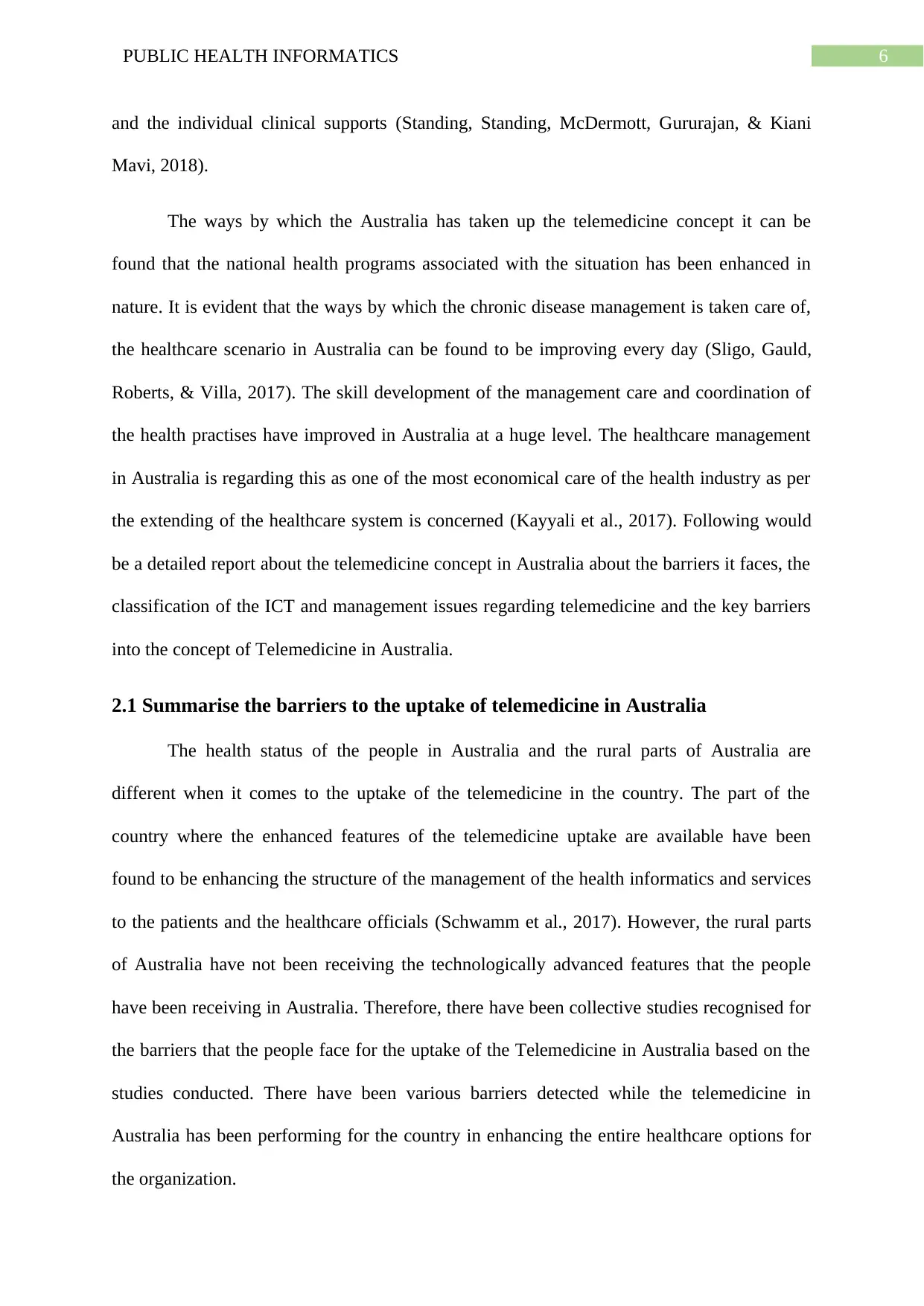
6PUBLIC HEALTH INFORMATICS
and the individual clinical supports (Standing, Standing, McDermott, Gururajan, & Kiani
Mavi, 2018).
The ways by which the Australia has taken up the telemedicine concept it can be
found that the national health programs associated with the situation has been enhanced in
nature. It is evident that the ways by which the chronic disease management is taken care of,
the healthcare scenario in Australia can be found to be improving every day (Sligo, Gauld,
Roberts, & Villa, 2017). The skill development of the management care and coordination of
the health practises have improved in Australia at a huge level. The healthcare management
in Australia is regarding this as one of the most economical care of the health industry as per
the extending of the healthcare system is concerned (Kayyali et al., 2017). Following would
be a detailed report about the telemedicine concept in Australia about the barriers it faces, the
classification of the ICT and management issues regarding telemedicine and the key barriers
into the concept of Telemedicine in Australia.
2.1 Summarise the barriers to the uptake of telemedicine in Australia
The health status of the people in Australia and the rural parts of Australia are
different when it comes to the uptake of the telemedicine in the country. The part of the
country where the enhanced features of the telemedicine uptake are available have been
found to be enhancing the structure of the management of the health informatics and services
to the patients and the healthcare officials (Schwamm et al., 2017). However, the rural parts
of Australia have not been receiving the technologically advanced features that the people
have been receiving in Australia. Therefore, there have been collective studies recognised for
the barriers that the people face for the uptake of the Telemedicine in Australia based on the
studies conducted. There have been various barriers detected while the telemedicine in
Australia has been performing for the country in enhancing the entire healthcare options for
the organization.
and the individual clinical supports (Standing, Standing, McDermott, Gururajan, & Kiani
Mavi, 2018).
The ways by which the Australia has taken up the telemedicine concept it can be
found that the national health programs associated with the situation has been enhanced in
nature. It is evident that the ways by which the chronic disease management is taken care of,
the healthcare scenario in Australia can be found to be improving every day (Sligo, Gauld,
Roberts, & Villa, 2017). The skill development of the management care and coordination of
the health practises have improved in Australia at a huge level. The healthcare management
in Australia is regarding this as one of the most economical care of the health industry as per
the extending of the healthcare system is concerned (Kayyali et al., 2017). Following would
be a detailed report about the telemedicine concept in Australia about the barriers it faces, the
classification of the ICT and management issues regarding telemedicine and the key barriers
into the concept of Telemedicine in Australia.
2.1 Summarise the barriers to the uptake of telemedicine in Australia
The health status of the people in Australia and the rural parts of Australia are
different when it comes to the uptake of the telemedicine in the country. The part of the
country where the enhanced features of the telemedicine uptake are available have been
found to be enhancing the structure of the management of the health informatics and services
to the patients and the healthcare officials (Schwamm et al., 2017). However, the rural parts
of Australia have not been receiving the technologically advanced features that the people
have been receiving in Australia. Therefore, there have been collective studies recognised for
the barriers that the people face for the uptake of the Telemedicine in Australia based on the
studies conducted. There have been various barriers detected while the telemedicine in
Australia has been performing for the country in enhancing the entire healthcare options for
the organization.
Paraphrase This Document
Need a fresh take? Get an instant paraphrase of this document with our AI Paraphraser
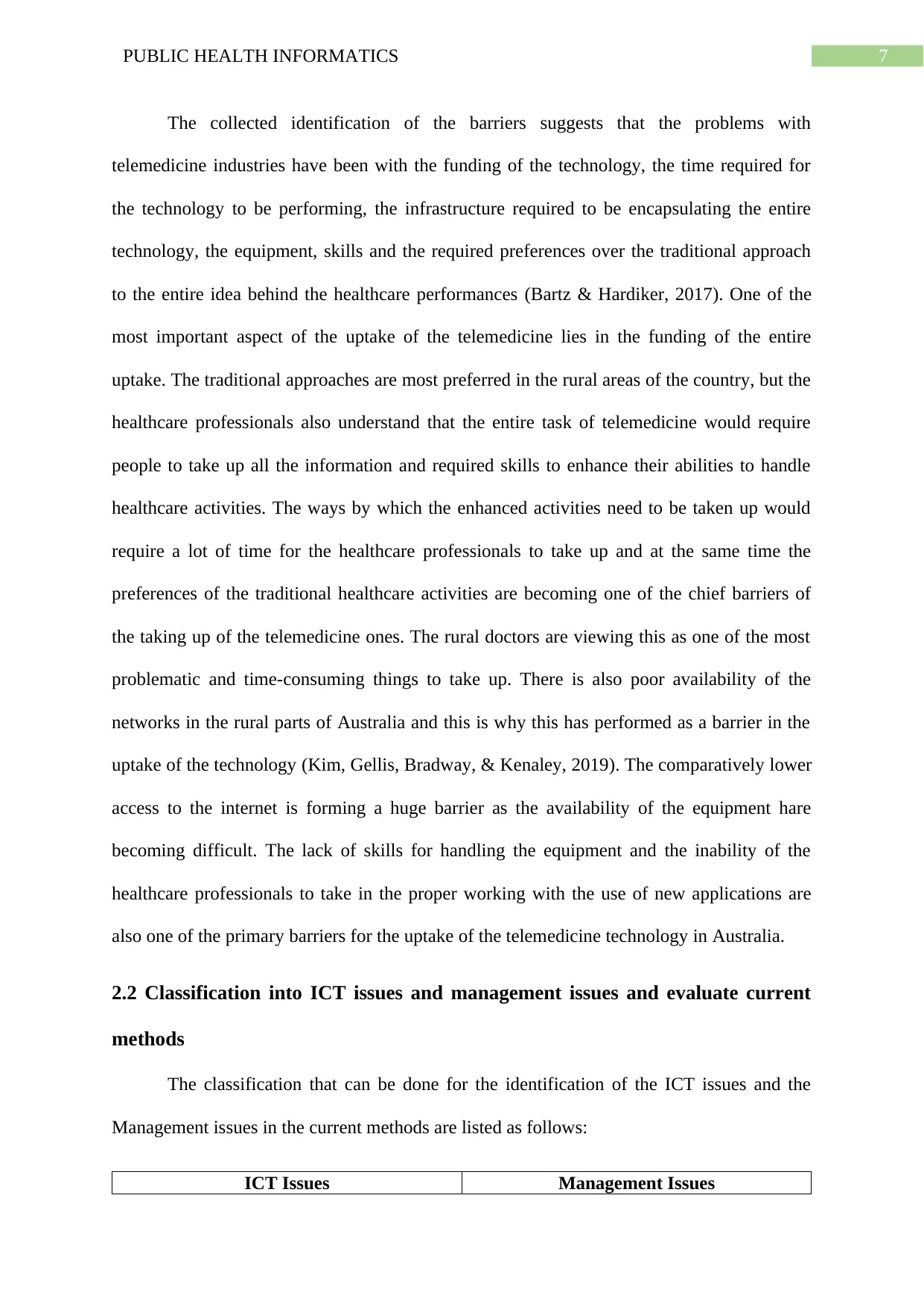
7PUBLIC HEALTH INFORMATICS
The collected identification of the barriers suggests that the problems with
telemedicine industries have been with the funding of the technology, the time required for
the technology to be performing, the infrastructure required to be encapsulating the entire
technology, the equipment, skills and the required preferences over the traditional approach
to the entire idea behind the healthcare performances (Bartz & Hardiker, 2017). One of the
most important aspect of the uptake of the telemedicine lies in the funding of the entire
uptake. The traditional approaches are most preferred in the rural areas of the country, but the
healthcare professionals also understand that the entire task of telemedicine would require
people to take up all the information and required skills to enhance their abilities to handle
healthcare activities. The ways by which the enhanced activities need to be taken up would
require a lot of time for the healthcare professionals to take up and at the same time the
preferences of the traditional healthcare activities are becoming one of the chief barriers of
the taking up of the telemedicine ones. The rural doctors are viewing this as one of the most
problematic and time-consuming things to take up. There is also poor availability of the
networks in the rural parts of Australia and this is why this has performed as a barrier in the
uptake of the technology (Kim, Gellis, Bradway, & Kenaley, 2019). The comparatively lower
access to the internet is forming a huge barrier as the availability of the equipment hare
becoming difficult. The lack of skills for handling the equipment and the inability of the
healthcare professionals to take in the proper working with the use of new applications are
also one of the primary barriers for the uptake of the telemedicine technology in Australia.
2.2 Classification into ICT issues and management issues and evaluate current
methods
The classification that can be done for the identification of the ICT issues and the
Management issues in the current methods are listed as follows:
ICT Issues Management Issues
The collected identification of the barriers suggests that the problems with
telemedicine industries have been with the funding of the technology, the time required for
the technology to be performing, the infrastructure required to be encapsulating the entire
technology, the equipment, skills and the required preferences over the traditional approach
to the entire idea behind the healthcare performances (Bartz & Hardiker, 2017). One of the
most important aspect of the uptake of the telemedicine lies in the funding of the entire
uptake. The traditional approaches are most preferred in the rural areas of the country, but the
healthcare professionals also understand that the entire task of telemedicine would require
people to take up all the information and required skills to enhance their abilities to handle
healthcare activities. The ways by which the enhanced activities need to be taken up would
require a lot of time for the healthcare professionals to take up and at the same time the
preferences of the traditional healthcare activities are becoming one of the chief barriers of
the taking up of the telemedicine ones. The rural doctors are viewing this as one of the most
problematic and time-consuming things to take up. There is also poor availability of the
networks in the rural parts of Australia and this is why this has performed as a barrier in the
uptake of the technology (Kim, Gellis, Bradway, & Kenaley, 2019). The comparatively lower
access to the internet is forming a huge barrier as the availability of the equipment hare
becoming difficult. The lack of skills for handling the equipment and the inability of the
healthcare professionals to take in the proper working with the use of new applications are
also one of the primary barriers for the uptake of the telemedicine technology in Australia.
2.2 Classification into ICT issues and management issues and evaluate current
methods
The classification that can be done for the identification of the ICT issues and the
Management issues in the current methods are listed as follows:
ICT Issues Management Issues
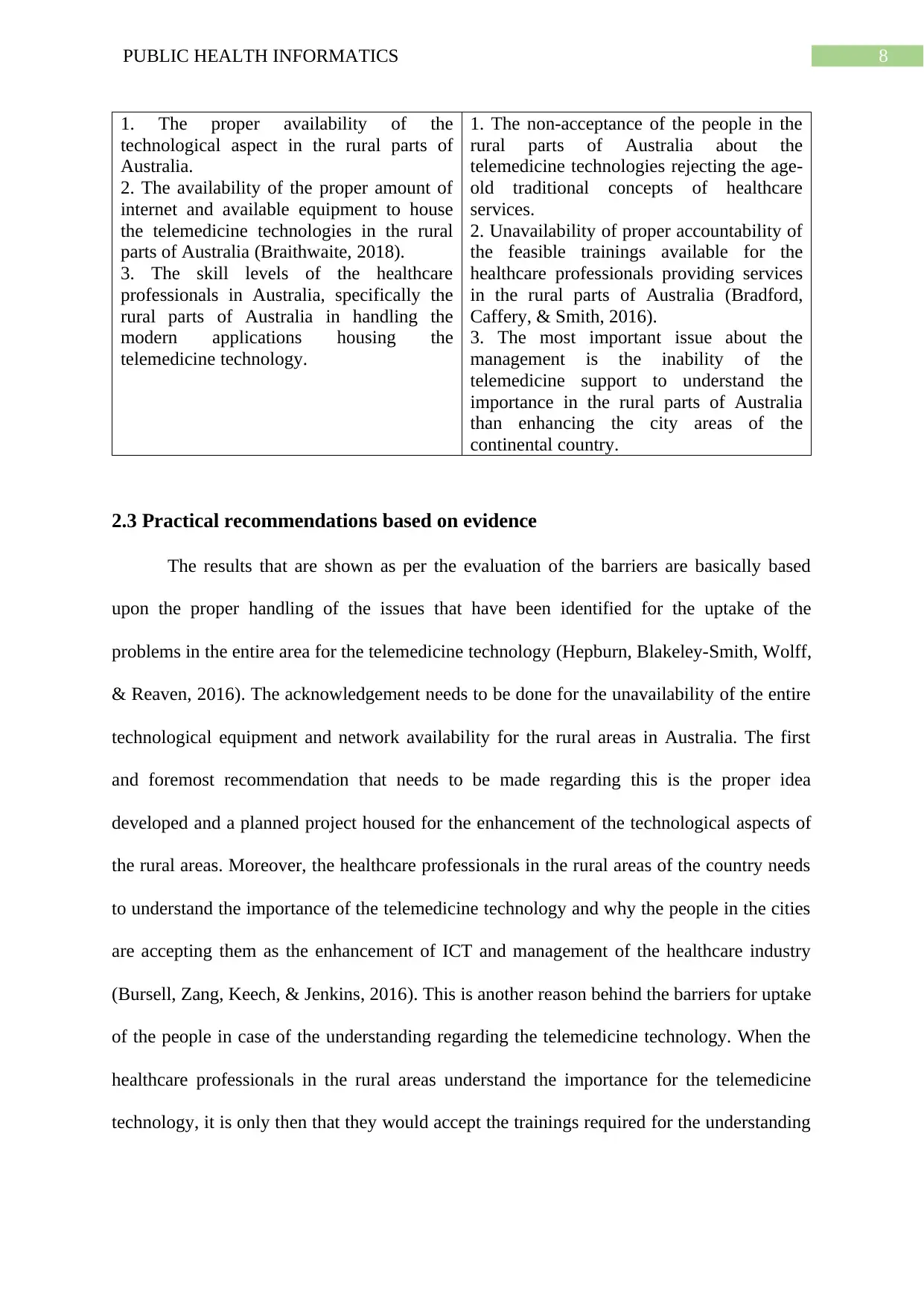
8PUBLIC HEALTH INFORMATICS
1. The proper availability of the
technological aspect in the rural parts of
Australia.
2. The availability of the proper amount of
internet and available equipment to house
the telemedicine technologies in the rural
parts of Australia (Braithwaite, 2018).
3. The skill levels of the healthcare
professionals in Australia, specifically the
rural parts of Australia in handling the
modern applications housing the
telemedicine technology.
1. The non-acceptance of the people in the
rural parts of Australia about the
telemedicine technologies rejecting the age-
old traditional concepts of healthcare
services.
2. Unavailability of proper accountability of
the feasible trainings available for the
healthcare professionals providing services
in the rural parts of Australia (Bradford,
Caffery, & Smith, 2016).
3. The most important issue about the
management is the inability of the
telemedicine support to understand the
importance in the rural parts of Australia
than enhancing the city areas of the
continental country.
2.3 Practical recommendations based on evidence
The results that are shown as per the evaluation of the barriers are basically based
upon the proper handling of the issues that have been identified for the uptake of the
problems in the entire area for the telemedicine technology (Hepburn, Blakeley-Smith, Wolff,
& Reaven, 2016). The acknowledgement needs to be done for the unavailability of the entire
technological equipment and network availability for the rural areas in Australia. The first
and foremost recommendation that needs to be made regarding this is the proper idea
developed and a planned project housed for the enhancement of the technological aspects of
the rural areas. Moreover, the healthcare professionals in the rural areas of the country needs
to understand the importance of the telemedicine technology and why the people in the cities
are accepting them as the enhancement of ICT and management of the healthcare industry
(Bursell, Zang, Keech, & Jenkins, 2016). This is another reason behind the barriers for uptake
of the people in case of the understanding regarding the telemedicine technology. When the
healthcare professionals in the rural areas understand the importance for the telemedicine
technology, it is only then that they would accept the trainings required for the understanding
1. The proper availability of the
technological aspect in the rural parts of
Australia.
2. The availability of the proper amount of
internet and available equipment to house
the telemedicine technologies in the rural
parts of Australia (Braithwaite, 2018).
3. The skill levels of the healthcare
professionals in Australia, specifically the
rural parts of Australia in handling the
modern applications housing the
telemedicine technology.
1. The non-acceptance of the people in the
rural parts of Australia about the
telemedicine technologies rejecting the age-
old traditional concepts of healthcare
services.
2. Unavailability of proper accountability of
the feasible trainings available for the
healthcare professionals providing services
in the rural parts of Australia (Bradford,
Caffery, & Smith, 2016).
3. The most important issue about the
management is the inability of the
telemedicine support to understand the
importance in the rural parts of Australia
than enhancing the city areas of the
continental country.
2.3 Practical recommendations based on evidence
The results that are shown as per the evaluation of the barriers are basically based
upon the proper handling of the issues that have been identified for the uptake of the
problems in the entire area for the telemedicine technology (Hepburn, Blakeley-Smith, Wolff,
& Reaven, 2016). The acknowledgement needs to be done for the unavailability of the entire
technological equipment and network availability for the rural areas in Australia. The first
and foremost recommendation that needs to be made regarding this is the proper idea
developed and a planned project housed for the enhancement of the technological aspects of
the rural areas. Moreover, the healthcare professionals in the rural areas of the country needs
to understand the importance of the telemedicine technology and why the people in the cities
are accepting them as the enhancement of ICT and management of the healthcare industry
(Bursell, Zang, Keech, & Jenkins, 2016). This is another reason behind the barriers for uptake
of the people in case of the understanding regarding the telemedicine technology. When the
healthcare professionals in the rural areas understand the importance for the telemedicine
technology, it is only then that they would accept the trainings required for the understanding
⊘ This is a preview!⊘
Do you want full access?
Subscribe today to unlock all pages.

Trusted by 1+ million students worldwide
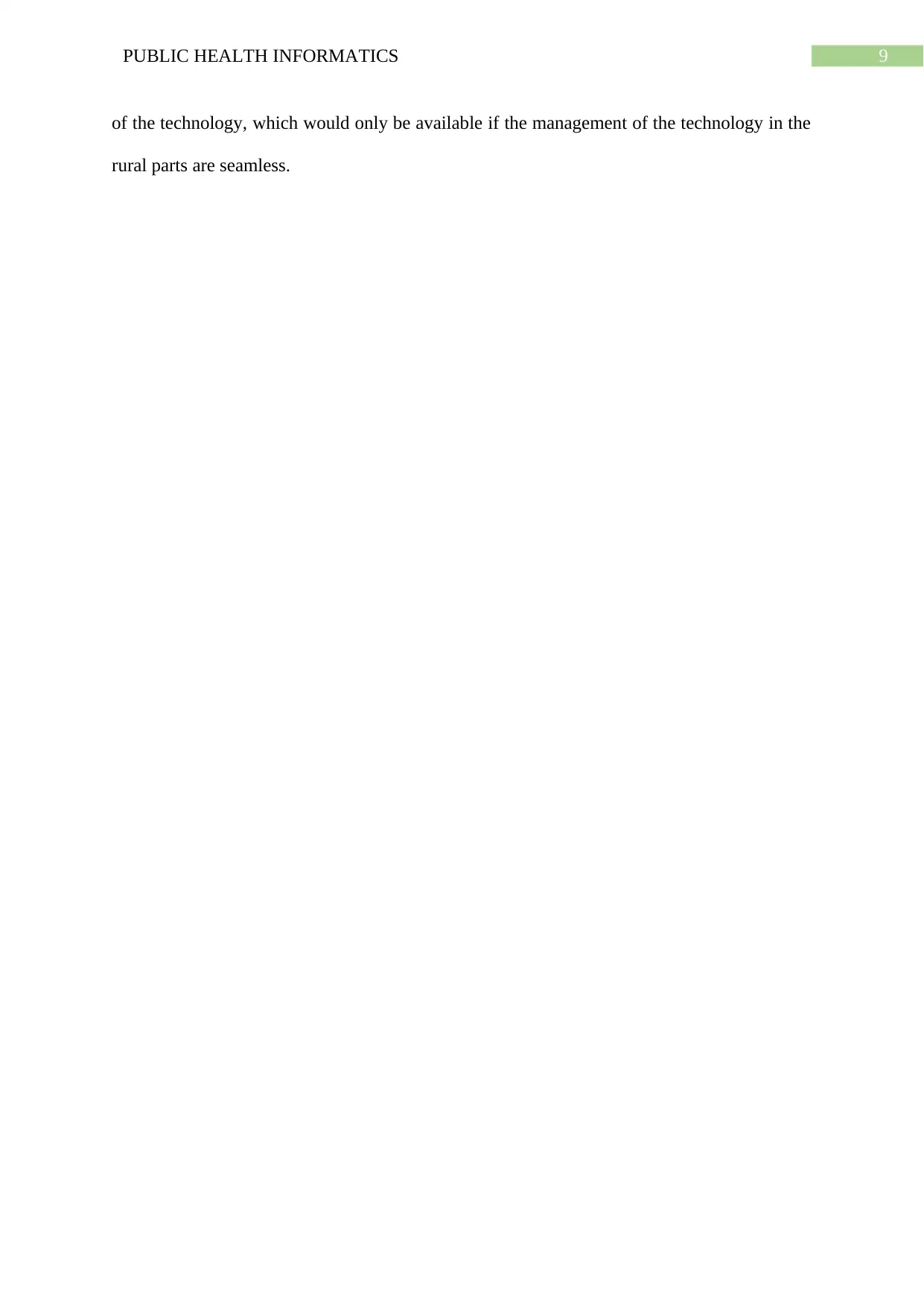
9PUBLIC HEALTH INFORMATICS
of the technology, which would only be available if the management of the technology in the
rural parts are seamless.
of the technology, which would only be available if the management of the technology in the
rural parts are seamless.
Paraphrase This Document
Need a fresh take? Get an instant paraphrase of this document with our AI Paraphraser
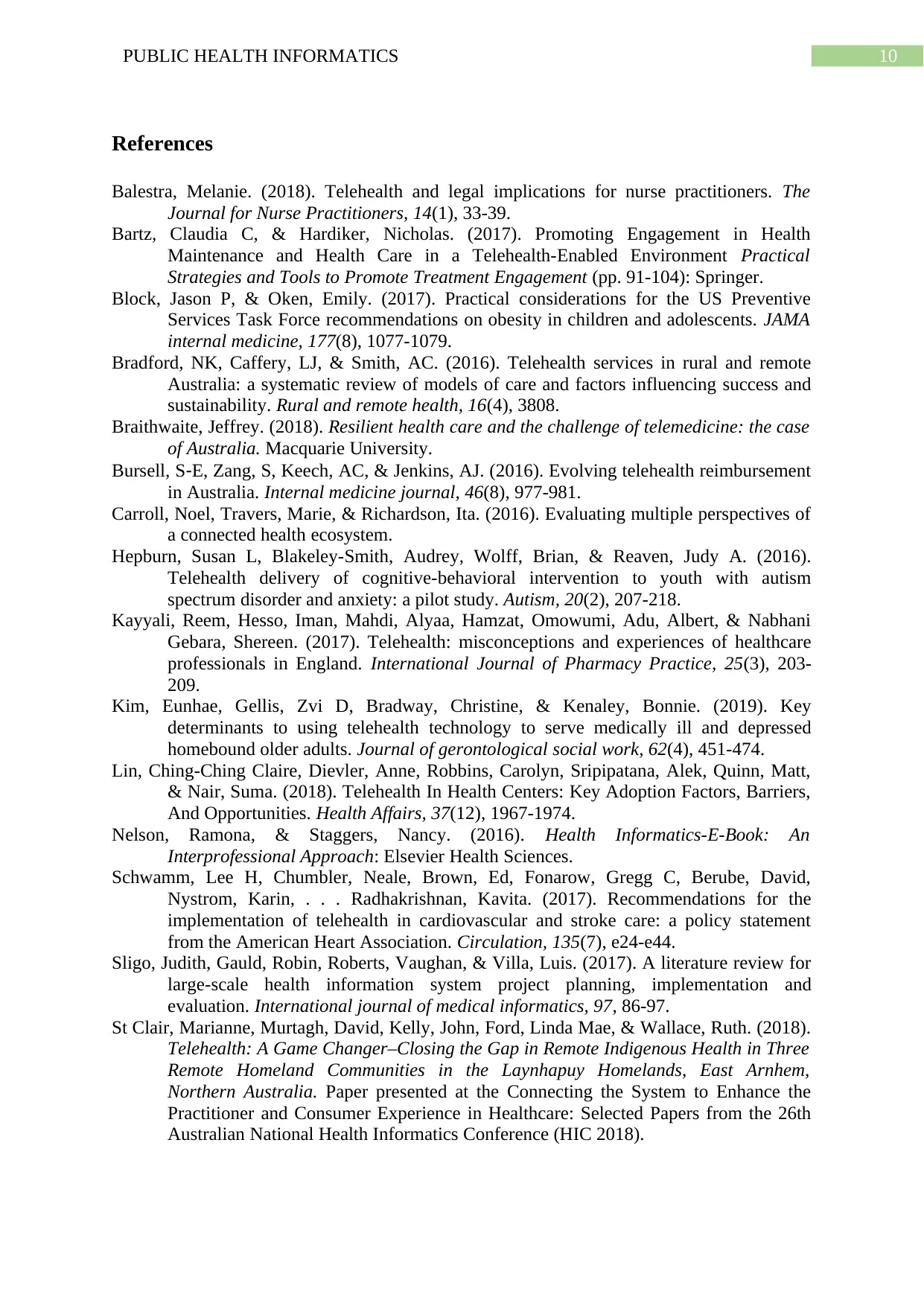
10PUBLIC HEALTH INFORMATICS
References
Balestra, Melanie. (2018). Telehealth and legal implications for nurse practitioners. The
Journal for Nurse Practitioners, 14(1), 33-39.
Bartz, Claudia C, & Hardiker, Nicholas. (2017). Promoting Engagement in Health
Maintenance and Health Care in a Telehealth-Enabled Environment Practical
Strategies and Tools to Promote Treatment Engagement (pp. 91-104): Springer.
Block, Jason P, & Oken, Emily. (2017). Practical considerations for the US Preventive
Services Task Force recommendations on obesity in children and adolescents. JAMA
internal medicine, 177(8), 1077-1079.
Bradford, NK, Caffery, LJ, & Smith, AC. (2016). Telehealth services in rural and remote
Australia: a systematic review of models of care and factors influencing success and
sustainability. Rural and remote health, 16(4), 3808.
Braithwaite, Jeffrey. (2018). Resilient health care and the challenge of telemedicine: the case
of Australia. Macquarie University.
Bursell, S‐E, Zang, S, Keech, AC, & Jenkins, AJ. (2016). Evolving telehealth reimbursement
in Australia. Internal medicine journal, 46(8), 977-981.
Carroll, Noel, Travers, Marie, & Richardson, Ita. (2016). Evaluating multiple perspectives of
a connected health ecosystem.
Hepburn, Susan L, Blakeley-Smith, Audrey, Wolff, Brian, & Reaven, Judy A. (2016).
Telehealth delivery of cognitive-behavioral intervention to youth with autism
spectrum disorder and anxiety: a pilot study. Autism, 20(2), 207-218.
Kayyali, Reem, Hesso, Iman, Mahdi, Alyaa, Hamzat, Omowumi, Adu, Albert, & Nabhani
Gebara, Shereen. (2017). Telehealth: misconceptions and experiences of healthcare
professionals in England. International Journal of Pharmacy Practice, 25(3), 203-
209.
Kim, Eunhae, Gellis, Zvi D, Bradway, Christine, & Kenaley, Bonnie. (2019). Key
determinants to using telehealth technology to serve medically ill and depressed
homebound older adults. Journal of gerontological social work, 62(4), 451-474.
Lin, Ching-Ching Claire, Dievler, Anne, Robbins, Carolyn, Sripipatana, Alek, Quinn, Matt,
& Nair, Suma. (2018). Telehealth In Health Centers: Key Adoption Factors, Barriers,
And Opportunities. Health Affairs, 37(12), 1967-1974.
Nelson, Ramona, & Staggers, Nancy. (2016). Health Informatics-E-Book: An
Interprofessional Approach: Elsevier Health Sciences.
Schwamm, Lee H, Chumbler, Neale, Brown, Ed, Fonarow, Gregg C, Berube, David,
Nystrom, Karin, . . . Radhakrishnan, Kavita. (2017). Recommendations for the
implementation of telehealth in cardiovascular and stroke care: a policy statement
from the American Heart Association. Circulation, 135(7), e24-e44.
Sligo, Judith, Gauld, Robin, Roberts, Vaughan, & Villa, Luis. (2017). A literature review for
large-scale health information system project planning, implementation and
evaluation. International journal of medical informatics, 97, 86-97.
St Clair, Marianne, Murtagh, David, Kelly, John, Ford, Linda Mae, & Wallace, Ruth. (2018).
Telehealth: A Game Changer–Closing the Gap in Remote Indigenous Health in Three
Remote Homeland Communities in the Laynhapuy Homelands, East Arnhem,
Northern Australia. Paper presented at the Connecting the System to Enhance the
Practitioner and Consumer Experience in Healthcare: Selected Papers from the 26th
Australian National Health Informatics Conference (HIC 2018).
References
Balestra, Melanie. (2018). Telehealth and legal implications for nurse practitioners. The
Journal for Nurse Practitioners, 14(1), 33-39.
Bartz, Claudia C, & Hardiker, Nicholas. (2017). Promoting Engagement in Health
Maintenance and Health Care in a Telehealth-Enabled Environment Practical
Strategies and Tools to Promote Treatment Engagement (pp. 91-104): Springer.
Block, Jason P, & Oken, Emily. (2017). Practical considerations for the US Preventive
Services Task Force recommendations on obesity in children and adolescents. JAMA
internal medicine, 177(8), 1077-1079.
Bradford, NK, Caffery, LJ, & Smith, AC. (2016). Telehealth services in rural and remote
Australia: a systematic review of models of care and factors influencing success and
sustainability. Rural and remote health, 16(4), 3808.
Braithwaite, Jeffrey. (2018). Resilient health care and the challenge of telemedicine: the case
of Australia. Macquarie University.
Bursell, S‐E, Zang, S, Keech, AC, & Jenkins, AJ. (2016). Evolving telehealth reimbursement
in Australia. Internal medicine journal, 46(8), 977-981.
Carroll, Noel, Travers, Marie, & Richardson, Ita. (2016). Evaluating multiple perspectives of
a connected health ecosystem.
Hepburn, Susan L, Blakeley-Smith, Audrey, Wolff, Brian, & Reaven, Judy A. (2016).
Telehealth delivery of cognitive-behavioral intervention to youth with autism
spectrum disorder and anxiety: a pilot study. Autism, 20(2), 207-218.
Kayyali, Reem, Hesso, Iman, Mahdi, Alyaa, Hamzat, Omowumi, Adu, Albert, & Nabhani
Gebara, Shereen. (2017). Telehealth: misconceptions and experiences of healthcare
professionals in England. International Journal of Pharmacy Practice, 25(3), 203-
209.
Kim, Eunhae, Gellis, Zvi D, Bradway, Christine, & Kenaley, Bonnie. (2019). Key
determinants to using telehealth technology to serve medically ill and depressed
homebound older adults. Journal of gerontological social work, 62(4), 451-474.
Lin, Ching-Ching Claire, Dievler, Anne, Robbins, Carolyn, Sripipatana, Alek, Quinn, Matt,
& Nair, Suma. (2018). Telehealth In Health Centers: Key Adoption Factors, Barriers,
And Opportunities. Health Affairs, 37(12), 1967-1974.
Nelson, Ramona, & Staggers, Nancy. (2016). Health Informatics-E-Book: An
Interprofessional Approach: Elsevier Health Sciences.
Schwamm, Lee H, Chumbler, Neale, Brown, Ed, Fonarow, Gregg C, Berube, David,
Nystrom, Karin, . . . Radhakrishnan, Kavita. (2017). Recommendations for the
implementation of telehealth in cardiovascular and stroke care: a policy statement
from the American Heart Association. Circulation, 135(7), e24-e44.
Sligo, Judith, Gauld, Robin, Roberts, Vaughan, & Villa, Luis. (2017). A literature review for
large-scale health information system project planning, implementation and
evaluation. International journal of medical informatics, 97, 86-97.
St Clair, Marianne, Murtagh, David, Kelly, John, Ford, Linda Mae, & Wallace, Ruth. (2018).
Telehealth: A Game Changer–Closing the Gap in Remote Indigenous Health in Three
Remote Homeland Communities in the Laynhapuy Homelands, East Arnhem,
Northern Australia. Paper presented at the Connecting the System to Enhance the
Practitioner and Consumer Experience in Healthcare: Selected Papers from the 26th
Australian National Health Informatics Conference (HIC 2018).
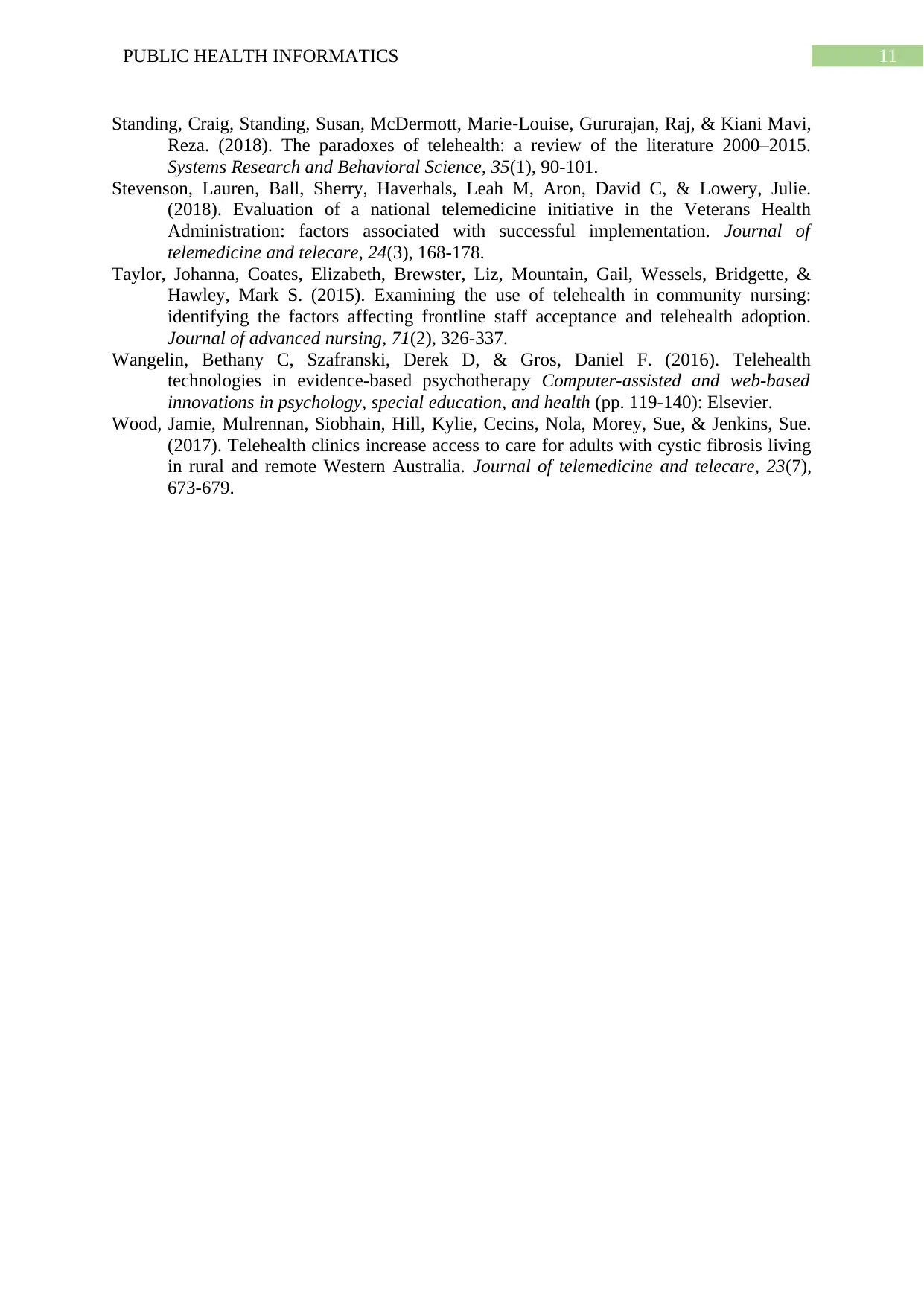
11PUBLIC HEALTH INFORMATICS
Standing, Craig, Standing, Susan, McDermott, Marie‐Louise, Gururajan, Raj, & Kiani Mavi,
Reza. (2018). The paradoxes of telehealth: a review of the literature 2000–2015.
Systems Research and Behavioral Science, 35(1), 90-101.
Stevenson, Lauren, Ball, Sherry, Haverhals, Leah M, Aron, David C, & Lowery, Julie.
(2018). Evaluation of a national telemedicine initiative in the Veterans Health
Administration: factors associated with successful implementation. Journal of
telemedicine and telecare, 24(3), 168-178.
Taylor, Johanna, Coates, Elizabeth, Brewster, Liz, Mountain, Gail, Wessels, Bridgette, &
Hawley, Mark S. (2015). Examining the use of telehealth in community nursing:
identifying the factors affecting frontline staff acceptance and telehealth adoption.
Journal of advanced nursing, 71(2), 326-337.
Wangelin, Bethany C, Szafranski, Derek D, & Gros, Daniel F. (2016). Telehealth
technologies in evidence-based psychotherapy Computer-assisted and web-based
innovations in psychology, special education, and health (pp. 119-140): Elsevier.
Wood, Jamie, Mulrennan, Siobhain, Hill, Kylie, Cecins, Nola, Morey, Sue, & Jenkins, Sue.
(2017). Telehealth clinics increase access to care for adults with cystic fibrosis living
in rural and remote Western Australia. Journal of telemedicine and telecare, 23(7),
673-679.
Standing, Craig, Standing, Susan, McDermott, Marie‐Louise, Gururajan, Raj, & Kiani Mavi,
Reza. (2018). The paradoxes of telehealth: a review of the literature 2000–2015.
Systems Research and Behavioral Science, 35(1), 90-101.
Stevenson, Lauren, Ball, Sherry, Haverhals, Leah M, Aron, David C, & Lowery, Julie.
(2018). Evaluation of a national telemedicine initiative in the Veterans Health
Administration: factors associated with successful implementation. Journal of
telemedicine and telecare, 24(3), 168-178.
Taylor, Johanna, Coates, Elizabeth, Brewster, Liz, Mountain, Gail, Wessels, Bridgette, &
Hawley, Mark S. (2015). Examining the use of telehealth in community nursing:
identifying the factors affecting frontline staff acceptance and telehealth adoption.
Journal of advanced nursing, 71(2), 326-337.
Wangelin, Bethany C, Szafranski, Derek D, & Gros, Daniel F. (2016). Telehealth
technologies in evidence-based psychotherapy Computer-assisted and web-based
innovations in psychology, special education, and health (pp. 119-140): Elsevier.
Wood, Jamie, Mulrennan, Siobhain, Hill, Kylie, Cecins, Nola, Morey, Sue, & Jenkins, Sue.
(2017). Telehealth clinics increase access to care for adults with cystic fibrosis living
in rural and remote Western Australia. Journal of telemedicine and telecare, 23(7),
673-679.
⊘ This is a preview!⊘
Do you want full access?
Subscribe today to unlock all pages.

Trusted by 1+ million students worldwide
1 out of 12
Related Documents
Your All-in-One AI-Powered Toolkit for Academic Success.
+13062052269
info@desklib.com
Available 24*7 on WhatsApp / Email
![[object Object]](/_next/static/media/star-bottom.7253800d.svg)
Unlock your academic potential
Copyright © 2020–2025 A2Z Services. All Rights Reserved. Developed and managed by ZUCOL.




